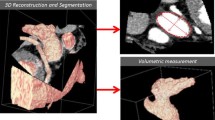Abstract
In this study, the left atrial appendage (LAA) structure and morphology were assessed using real-time three-dimensional transesophageal echocardiography (RT3D-TEE) and enhanced cardiac computed tomography (CT) scanning, and the two measurements obtained using these different techniques were compared. Two hundred nonvalvular atrial fibrillation (NVAF) patients who were prepared to undergo radiofrequency ablation were enrolled, and 62 controls were enrolled prospectively. RT3D-TEE and CT were performed, and the following parameters were measured: LAA orifice diameter, area, depth, maximum volume, and emptying velocity. The differences between the NVAF patients and controls were compared, and the differences and correlations in the LAA parameters between the two imaging techniques were assessed. The NVAF patients had significantly bigger orifice sizes, orifice areas, and maximum volumes, and lower emptying rates. The AF cohort had roughly equal proportions of the four morphological types, whereas the controls predominantly had the windsock type. A Bland–Altman analysis demonstrated that the LAA measurements obtained using RT3D-TEE were lower than those obtained with the CT. However, linear regression analysis showed the good correlations between the RT3D-TEE and CT measurements of the LAA orifice area, depth and volume (r = 0.86, 0.63, and 0.75, respectively). The use of RT3D-TEE for the visualization and quantitative analysis of LAA parameters is feasible, and the obtained measurements correlate well with those obtained with cardiac CT. This technique may be an ideal tool for guiding LAA occlusion procedures, and combining these two methods may enhance the accuracy of LAA measurements.








Similar content being viewed by others
References
Odell JA, Blackshear JL, Davies E, Byrne WJ, Kollmorgen CF, Edwards WD et al (1996) Thoracoscopic obliteration of the left atrial appendage: potential for stroke reduction? Ann Thorac Surg 61:565–569
Di Biase L, Santangeli P, Anselmino M, Mohanty P, Salvetti I, Gili S et al (2012) Does the left atrial appendage morphology correlate with the risk of stroke in patients with atrial fibrillation? Results from a multicenter study. J Am Coll Cardiol 60:531–538
Budge LP, Shaffer KM, Moorman JR, Lake DE, Ferguson JD, Mangrum JM (2008) Analysis of in vivo left atrial appendage morphology in patients with atrial fibrillation: a direct comparison of transesophageal echocardiography, planar cardiac CT, and segmented three-dimensional cardiac CT. J Interv Card Electrophysiol 23:87–93
Ismail TF, Panikker S, Markides V, Foran JP, Padley S, Rubens MB et al (2015) CT imaging for left atrial appendage closure: a review and pictorial essay. J Cardiovasc Comput Tomogr 9:89–102
Wann LS, Curtis AB, Ellenbogen KA, Estes NA 3rd, Ezekowitz MD, Jackman WM et al (2011) ACCF/AHA/HRS focused update on the management of patients with atrial fibrillation (update on dabigatran): a report of the American College of Cardiology Foundation/American Heart Association Task Force on practice guidelines. J Am Coll Cardiol 57:1330–7
Veinot JP, Harrity PJ, Gentile F, Khandheria BK, Bailey KR, Eickholt JT et al (1997) Anatomy of the normal left atrial appendage: a quantitative study of age-related changes in 500 autopsy hearts: implications for echocardiographic examination. Circulation 96:3112–3115
Ernst G, Stollberger C, Abzieher F, Veit-Dirscherl W, Bonner E, Bibus B et al (1995) Morphology of the left atrial appendage. Anat Rec 242:553–561
Hoit BD, Walsh RA (1992) Regional atrial distensibility. Am J Physiol 262:H1356–H1360
Tabata T, Oki T, Yamada H, Iuchi A, Ito S, Hori T et al (1998) Role of left atrial appendage in left atrial reservoir function as evaluated by left atrial appendage clamping during cardiac surgery. Am J Cardiol 81:327–332
Nakajima H, Seo Y, Ishizu T, Yamamoto M, Machino T et al (2010) Analysis of the left atrial appendage by three-dimensional transesophageal echocardiography. Am J Cardiol 106(6):885–892
Chen OD, Wu WC, Jiang Y, Xiao MH, Wang H (2012) Assessment of the morphology and mechanical function of the left atrial appendage by real-time three-dimensional transesophageal echocardiography. Chin Med J (Engl) 125(19):3416–3420
Lupercio F, Carlos Ruiz J, Briceno DF, Romero J, Villablanca PA et al (2016) Left atrial appendage morphology assessment for risk stratification of embolic stroke in patients with atrial fibrillation: a meta-analysis. Heart Rhythm 13(7):1402–1409
Khurram IM, Dewire J, Mager M, Maqbool F, Zimmerman SL, Zipunnikov V et al (2013) Relationship between left atrial appendage morphology and stroke in patients with atrial fibrillation. Heart Rhythm 10:1843–1849
Wang Y, Di Biase L, Horton RP, Nguyen T, Morhanty P, Natale A (2010) Left atrial appendage studied by computed tomography to help planning for appendage closure device placement. J Cardiovasc Electrophysiol 21:973–982
Kimura T, Takatsuki S, Inagawa K, Katsumata Y, Nishiyama T, Nishiyama N et al (2013) Anatomical characteristics of the left atrial appendage in cardiogenic stroke with low CHADS2 scores. Heart Rhythm 10:921–925
Nucifora G, Faletra FF, Regoli F, Pasotti E, Pedrazzini G, Moccetti T et al (2011) Evaluation of the left atrial appendage with real-time 3-dimensional transesophageal echocardiography: implications for catheter-based left atrial appendage closure. Circ Cardiovasc Imaging 4:514–523
Shah SJ, Bardo DM, Sugeng L, Weinert L, Lodato JA, Knight BP et al (2008) Real-time three-dimensional transesophageal echocardiography of the left atrial appendage: initial experience in the clinical setting. J Am Soc Echocardiogr 21:1362–1368
Dudzinski DM, Schwartzenberg S, Upadhyay GA, Hung J (2014) Role of transesophageal echocardiography in left atrial appendage device closure. Intervent. Cardiol Clin 3:255–280
Acknowledgements
This study was supported by the grant from Science and Technology Pillar Programmes of Sichuan Province (Grant no. 2014SZ0004-8) and supported by the grant from Chinese Medical Doctor Association. The funders had no role in study design, data collection and analysis, decision to publish, or preparation of the manuscript.
Author information
Authors and Affiliations
Corresponding author
Ethics declarations
Conflict of interest
No conflict of interest.
Additional information
Wenjuan Bai and Zhongxiu Chen have contributed equally to this study.
Rights and permissions
About this article
Cite this article
Bai, W., Chen, Z., Tang, H. et al. Assessment of the left atrial appendage structure and morphology: comparison of real-time three-dimensional transesophageal echocardiography and computed tomography. Int J Cardiovasc Imaging 33, 623–633 (2017). https://doi.org/10.1007/s10554-016-1044-4
Received:
Accepted:
Published:
Issue Date:
DOI: https://doi.org/10.1007/s10554-016-1044-4




